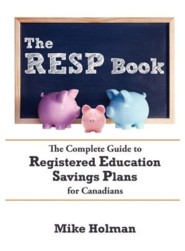Congratulations, your child has been accepted into their post-secondary school of choice. Luckily, you have a decent sized RESP account and now need to plan your RESP withdrawals. The following steps and strategies will help you deplete the RESP with a minimum of surprises.
Step 1 – Make sure the money is safe
If your child is starting school in September or is currently attending , the RESP should only be invested in safe investments such as GICs and cash. If you own any equities, you are taking an extra risk. Make sure you understand what your investment time horizon is. Don’t try to play the markets – at this point you need to make sure that the money will be there when the student needs it.
Step 2 – Learn the RESP withdrawal rules
In your RESP account, there are two kinds of money: Contributions and Accumulated Income.
- Contribution amount is the sum of all the contributions that you made to the account over the years. This money can be withdrawn tax-free. These withdrawals are called Post-Secondary Education Payments (PSE).
- Accumulated Income is made up of grants, capital gains, interest, dividends earned in the account. Any money that is not a contribution is Accumulated Income. Withdrawals of Accumulated Income for educational purposes are taxed in the hands of the student. These are called Educational Assistance Payments (EAP).
To make withdrawals from an RESP account, proof of enrolment must be provided to your financial institution. No receipts are necessary.
When requesting RESP withdrawals, you can specify whether the money will be coming from the Contribution or Accumulated Income portion or a combination of both. If you don’t specify which type of withdrawal you are making, most financial institutions usually withdraw the money from the Accumulated Income.
Here is a good list of RESP withdrawal rules.
Step 3 – Determine contribution and grant amounts
In order to plan, you need information. You should call your advisor or financial institution and ask for the following information:
- Account value
- Total amount of contributions made for the beneficiary
- Total amount of grants paid to beneficiary
To calculate the amount of Accumulated Income (non-contributions), just subtract the contributions amount from the account value. The grant amount will be used later to determine if more contributions can be made.
Step 4 – Plan withdrawals for tax efficiency
When your child goes to school, withdrawals from the Accumulated Income portion of the RESP are taxable in the hands of the student. Ideally, you should try to manage these payouts to minimize taxes. Withdraw more Accumulated Income in years when the student has low income, and less in years where their income is higher. Full time students often have generous school-related tax credits in addition to their personal exemption. Make use of this fact to withdraw as much Accumulated Income from the RESP account tax-free as possible.
Withdrawals from contributions have no tax implications, so the timing doesn’t matter.
Here are some withdrawal strategies to consider:
Maximize the Accumulated Income withdrawal in the first semester
The year a student starts school is often a low-income year, so withdrawing more Accumulated Income could save taxes. Only $5,000 of Accumulated Income can be withdrawn in the first 13 weeks of school. There is no withdrawal limit on contributions. If the child starts school at the beginning of September, they can take out more Accumulated Income by mid-December of that same tax year.
Don’t leave Accumulated Income in the account
If Accumulated Income is withdrawn when the child is not attending school, the money is taxed in the hands of the subscriber and an additional 20% tax is applied. When planning your withdrawals, do your best to ensure that the Accumulated Income is completely withdrawn before the student graduates. You don’t have to match the withdrawal amounts to the educational expenses, you can take out extra and save it in a TFSA or non-registered account.
Accumulated Income is allowed to be withdrawn as an EAP, for up to six months after the child stops attending school. This can be useful if the child unexpectedly quits before graduating.
Here are some strategies for removing excess money from your RESP account.
Family plan grant trap
When requesting withdrawals from a family plan RESP – don’t give more than $7,200 worth of grant money to any one beneficiary or the government will take the excess grant money back. All payments from Accumulated Income will include grant money. Check with your financial institution to monitor how much grant money has been paid to each beneficiary.
Last chance contribution
If the amount of grants from Step 3 is less than the lifetime grant limit of $7,200, you can still make more RESP contributions. Contributions can be made up to December 31st of the year the child turns 17, even if the beneficiary has already made a withdrawal from the RESP.
Here are the RESP contribution rules for kids 15,16 and 17 years of age.
Conclusion
The withdrawal phase of your RESP account is the most complicated phase of the RESP program. Take the time to learn the rules and you won’t have any unpleasant tax bills or grant clawbacks.

